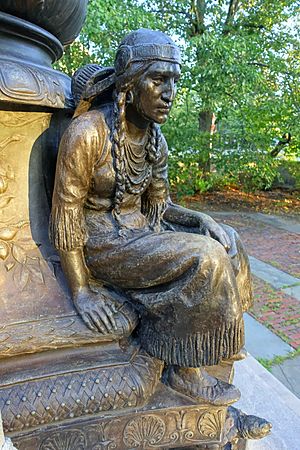Squaw Sachem of Mistick facts for kids
Squaw Sachem of Mistick (born around 1590, died between 1650 and 1667) was an important leader of a Native American tribe called the Massachusett. She was known for giving or selling large areas of land in what is now eastern Massachusetts to early European settlers.
Her original name is not known. She was called "Squaw Sachem" in official documents. A "Sachem" was a leader or chief of a Native American tribe. She was the widow of Nanepashemet, who was the Sachem of the Pawtucket Confederation of Indian tribes. He passed away in 1619.
Her Life and Leadership
After Nanepashemet's death, Squaw Sachem became the strong and capable leader of the Pawtucket Confederation lands. Around 1635, she and other Native Americans gave land in Concord, Massachusetts to colonists. By this time, she had married again to a tribal priest named Wompachowet, also known as Webcowit.
In 1639, she gave land that is now part of Cambridge and Watertown to the colonists. This area covers much of what is now the Greater Boston area. It includes towns like Newton, Arlington, Somerville, Malden, and Charlestown.
Squaw Sachem spent her final years near the Mystic Lakes in what is now Medford, Massachusetts. She passed away sometime between 1650 and 1667. Today, she is remembered on the Boston Women's Heritage Trail. Her sons, Wonohaquaham, Montowampate, and Wenepoykin, also became tribal leaders. Sometimes, people confuse her with other Native American women leaders from that time who were also called Squaw Sachem, such as Awashonks and Weetamoo.
The Sachem Name Controversy
Using the name or image of Squaw Sachem of Mistick has caused disagreements. Some Native American groups and social justice organizations have spoken out against it. For over 20 years, there has been an effort to stop using the Sachem name and image as a mascot or logo in nearby towns.
In 2020, the Sachem was removed as the mascot for the public schools in Winchester, Massachusetts. People who support mascots often say they want to honor Native Americans. They might refer to qualities like being strong, brave, or proud. However, those who oppose the mascots believe these images are based on harmful stereotypes. They feel these images do not truly represent Native American people.
The use of American Indian mascots as symbols in schools and university athletic programs is particularly troubling because schools are places of learning. These mascots are teaching stereotypical, misleading and too often, insulting images of American Indians. These negative lessons are not just affecting American Indian students; they are sending the wrong message to all students.
— Former APA President Ronald F. Levant, EdD


